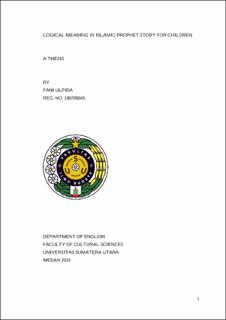Logical Meaning in Islamic Prophet Story for Children

Date
2024Author
Ulfida, Fani
Advisor(s)
Zein, T Thyrhaya
Yusuf, Muhammad
Metadata
Show full item recordAbstract
This research was conducted to analyze the grammatical realization of the logical meaning of complex clauses contained in an Islamic prophet storybook for children entitled Best Loved Prophet Muhammad Stories. Logical meaning in this research refers to the theoretical framework of clause complexes in systemic functional linguistics (SFL) that proposed by Halliday & Matthiessen. Research design of this study was qualitative approach with interactive design. The findings show that the clauses in the Islamic prophet story under study use clause complexes (58,22%) more than clause simplexes (41,78%), showing the complexity of its clause structure. The Islamic prophet story contains taxis and logico-semantics. Taxis consist of parataxis and hypotaxis. Logico-semantic consist of expansion and projection that can be combined with the parataxis and hypotaxis relation. It can be seen through parataxis and hypotaxis elaboration, parataxis and hypotaxis extension, parataxis and hypotaxis enhancement, parataxis and hypotaxis idea, and parataxis and hypotaxis locution. The relation of logico-semantic and taxis relation are realized in this Islamic prophet story. In taxis relations, parataxis shown through comma and coordination conjunction. Furthermore, hypotaxis shown through comma and subordination conjunction. In the case of logico-semantic relations, based on the kinds of each expansion they were elaboration that realized through specification, clarification, exemplification, and exposition. Extension realized through addition and variation, and there was no addition negative realization. Enhancement realized through temporal, causal, manner, and spatial, and there was no conditional and concessive realization. Based on kinds of projection, idea projected by mental process and locution projected by verbal process.
Collections
- Undergraduate Theses [873]
